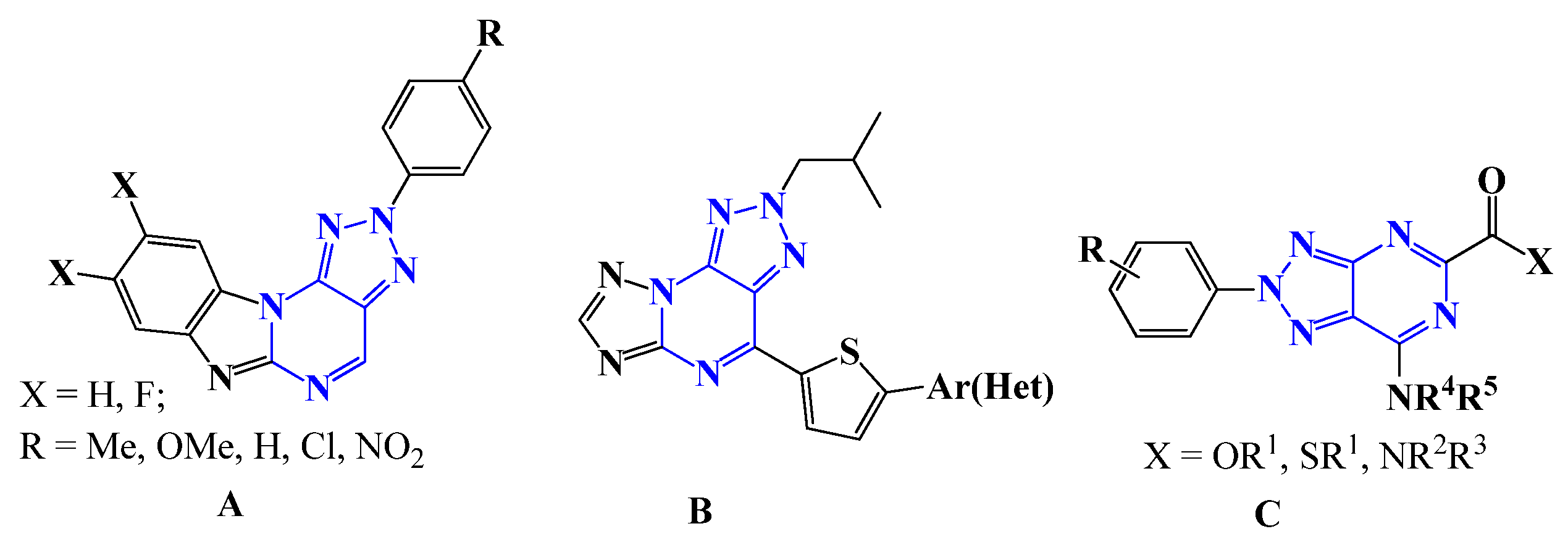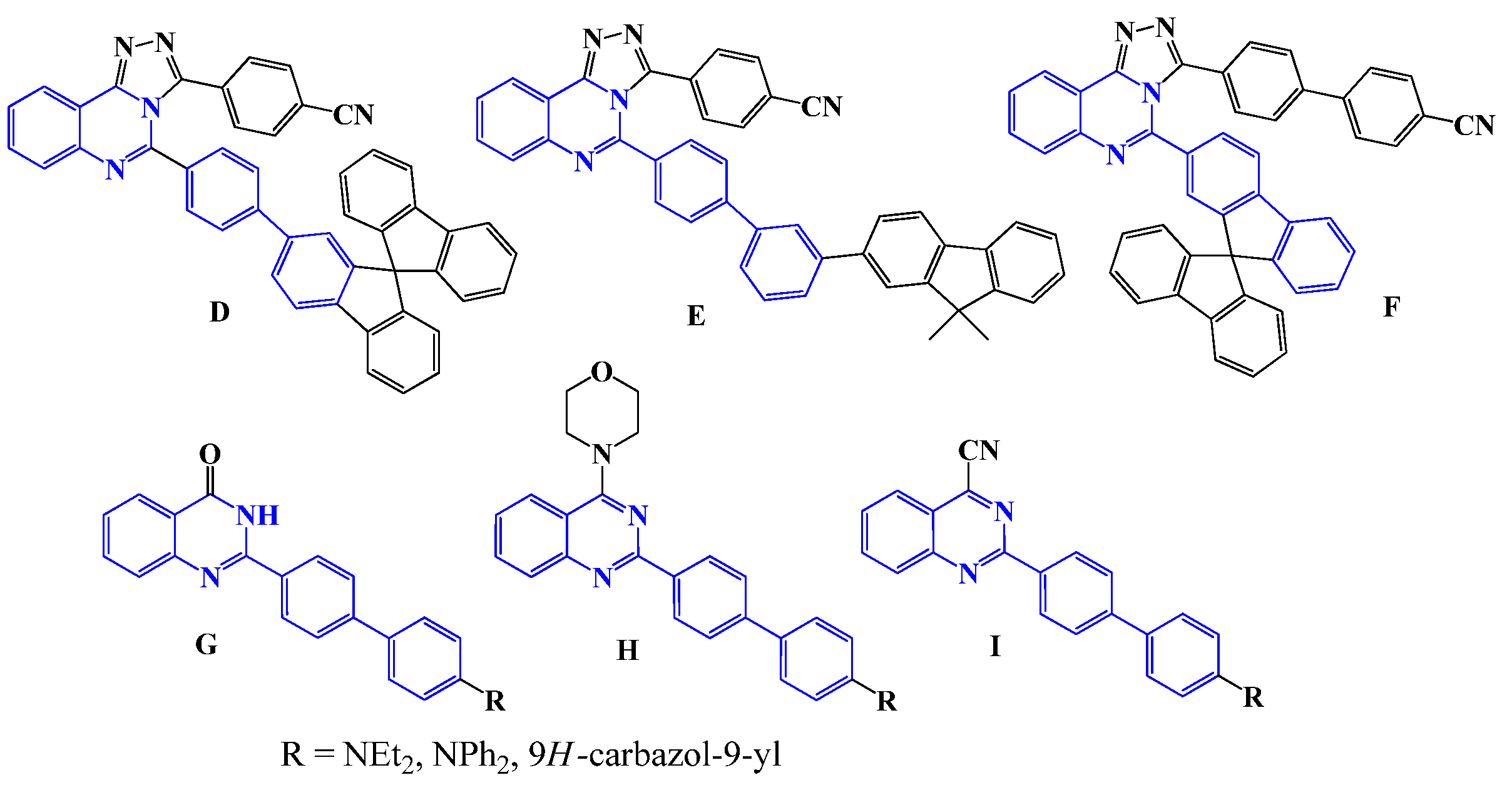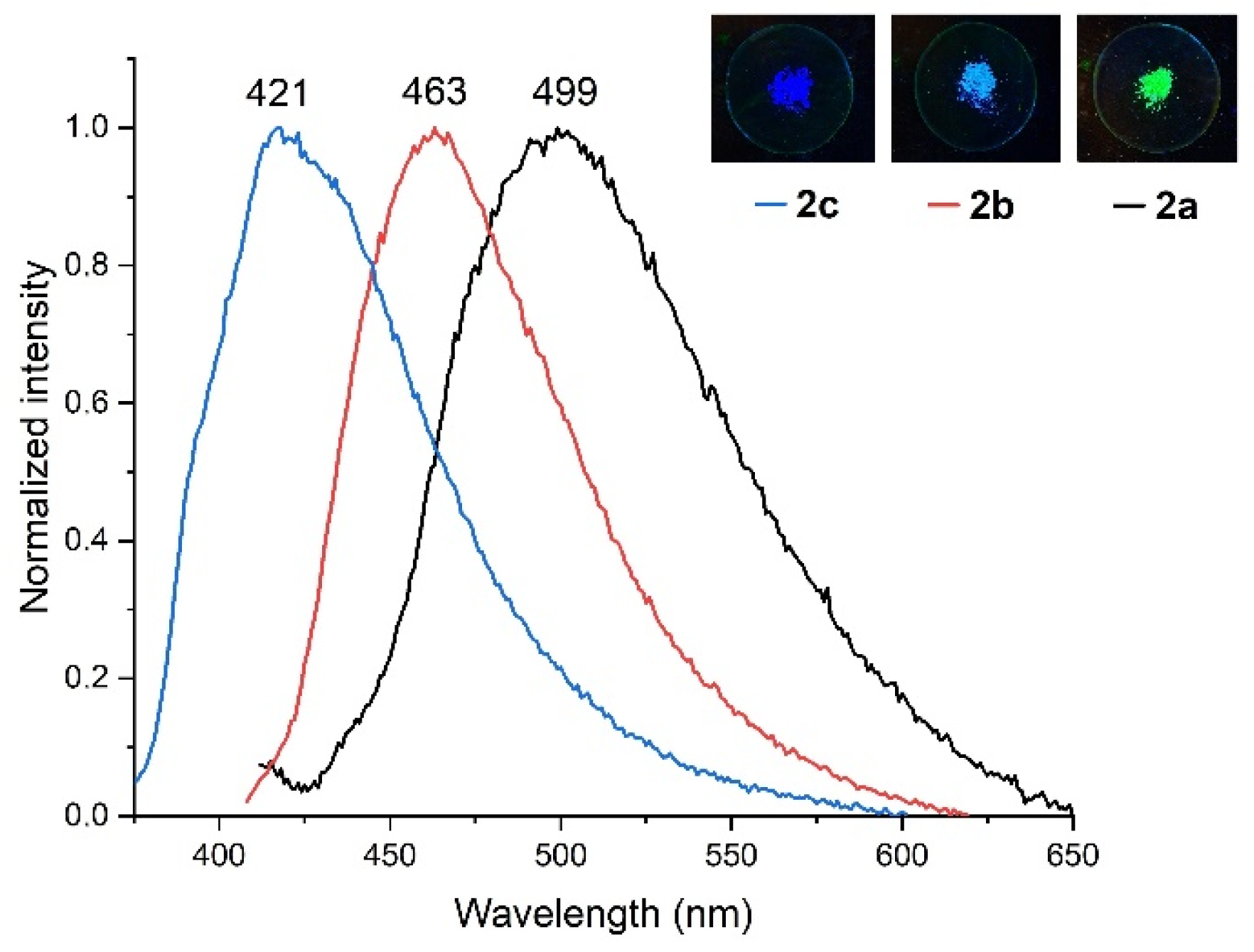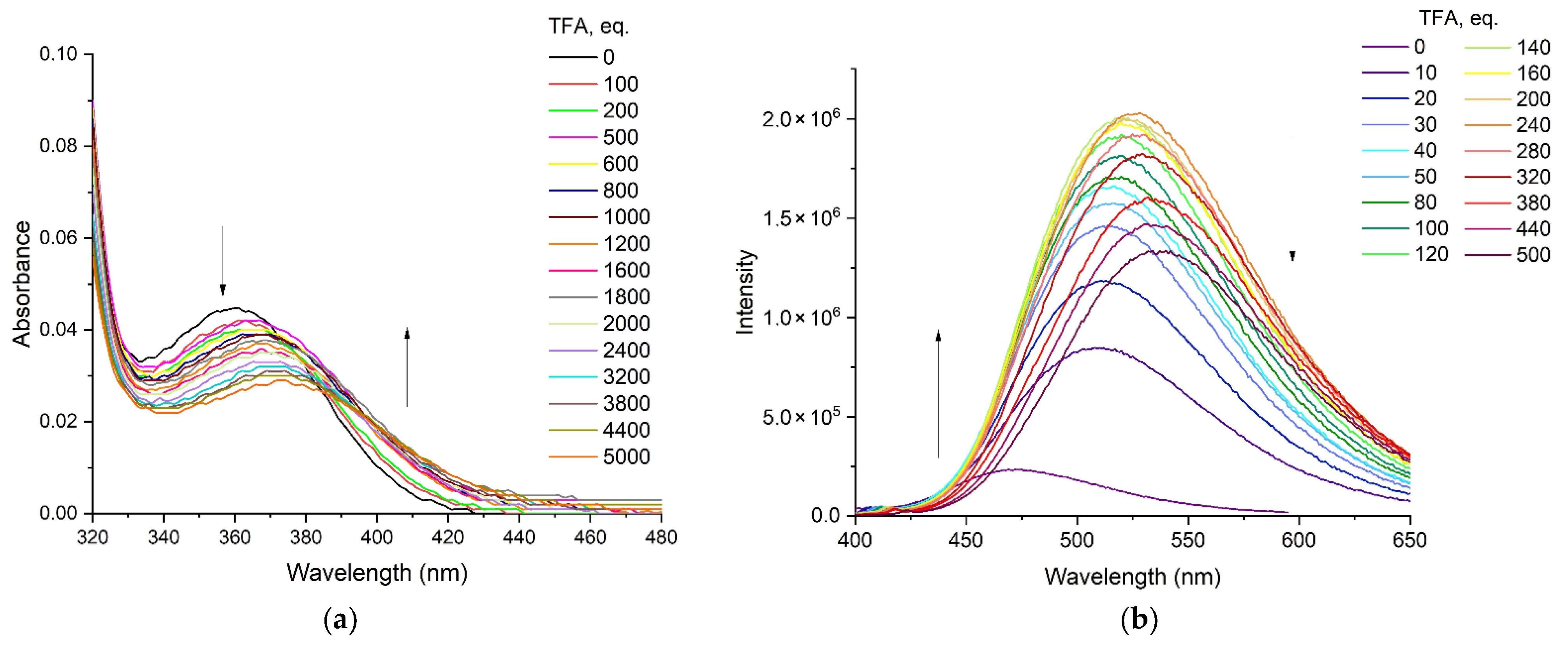3-Aryl-5-aminobiphenyl Substituted [1,2,4]triazolo[4,3-c]quinazolines: Synthesis and Photophysical Properties
Abstract
1. Introduction
2. Results
2.1. Synthesis
2.2. UV/Vis and Fluorescence Spectroscopy
2.3. Effects of Solvent Polarity for 2a, d, g, h
2.4. Absorption and Fluorescence Behavior of Compounds 2b, 2e and 2h in MeCN/water Mixture
2.5. Absorption and Fluorescence Behavior of Compounds 2e and 2h in Acidic Media
2.6. Quantum-Chemical Calculations
3. Experimental Methods
3.1. General Information
3.2. Photophysical Characterization
3.3. Crystallography
3.4. General Procedures of Suzuki Cross-Coupling
4. Conclusions
Supplementary Materials
Author Contributions
Funding
Institutional Review Board Statement
Informed Consent Statement
Data Availability Statement
Acknowledgments
Conflicts of Interest
Sample Availability
References
- Singh, P.K.; Choudhary, S.; Kashyap, A.; Verma, H.; Kapil, S.; Kumar, M.; Arora, M.; Silakari, O. An Exhaustive Compilation on Chemistry of Triazolopyrimidine: A Journey through Decades. Bioorg. Chem. 2019, 88, 102919. [Google Scholar] [CrossRef] [PubMed]
- Zuniga, E.S.; Korkegian, A.; Mullen, S.; Hembre, E.J.; Ornstein, P.L.; Cortez, G.; Biswas, K.; Kumar, N.; Cramer, J.; Masquelin, T.; et al. The Synthesis and Evaluation of Triazolopyrimidines as Anti-Tubercular Agents. Bioorg. Med. Chem. 2017, 25, 3922–3946. [Google Scholar] [CrossRef] [PubMed]
- Jacobson, K.A.; Boeynaems, J.-M. P2Y Nucleotide Receptors: Promise of Therapeutic Applications. Drug Discov. Today 2010, 15, 570–578. [Google Scholar] [CrossRef] [PubMed]
- Zhang, N.; Ayral-Kaloustian, S.; Nguyen, T.; Hernandez, R.; Lucas, J.; Discafani, C.; Beyer, C. Synthesis and SAR of 6-Chloro-4-Fluoroalkylamino-2-Heteroaryl-5-(Substituted)Phenylpyrimidines as Anti-Cancer Agents. Bioorg. Med. Chem. 2009, 17, 111–118. [Google Scholar] [CrossRef] [PubMed]
- El-Adl, K.; Ibrahim, M.-K.; Alesawy, M.S.I.; Eissa, I.H. [1,2,4]Triazolo[4,3-c]Quinazoline and Bis([1,2,4]Triazolo)[4,3-a:4′,3′-c]Quinazoline Derived DNA Intercalators: Design, Synthesis, in Silico ADMET Profile, Molecular Docking and Anti-Proliferative Evaluation Studies. Bioorg. Med. Chem. 2021, 30, 115958. [Google Scholar] [CrossRef]
- El-Adl, K.; Ibrahim, M.; Alesawy, M.S.; Eissa, I.H. Triazoloquinazoline Derived Classical DNA Intercalators: Design, Synthesis, in Silico ADME Profile, Docking, and Antiproliferative Evaluations. Arch. Pharm. 2022, 355, 2100506. [Google Scholar] [CrossRef]
- Burbiel, J.C.; Ghattas, W.; Küppers, P.; Köse, M.; Lacher, S.; Herzner, A.-M.; Kombu, R.S.; Akkinepally, R.R.; Hockemeyer, J.; Müller, C.E. 2-Amino[1,2,4]Triazolo[1,5-c]Quinazolines and Derived Novel Heterocycles: Syntheses and Structure-Activity Relationships of Potent Adenosine Receptor Antagonists. ChemMedChem 2016, 11, 2272–2286. [Google Scholar] [CrossRef]
- Zheng, Y.; Bian, M.; Deng, X.-Q.; Wang, S.-B.; Quan, Z.-S. Synthesis and Anticonvulsant Activity Evaluation of 5-Phenyl-[1,2,4]Triazolo[4,3-c]Quinazolin-3-Amines. Arch. Pharm. 2013, 346, 119–126. [Google Scholar] [CrossRef]
- Esteban-Parra, G.M.; Sebastián, E.S.; Cepeda, J.; Sánchez-González, C.; Rivas-García, L.; Llopis, J.; Aranda, P.; Sánchez-Moreno, M.; Quirós, M.; Rodríguez-Diéguez, A. Anti-Diabetic and Anti-Parasitic Properties of a Family of Luminescent Zinc Coordination Compounds Based on the 7-Amino-5-Methyl-1,2,4-Triazolo[1,5-a]Pyrimidine Ligand. J. Inorg. Biochem. 2020, 212, 111235. [Google Scholar] [CrossRef]
- Oukoloff, K.; Kovalevich, J.; Cornec, A.S.; Yao, Y.; Owyang, Z.A.; James, M.; Trojanowski, J.Q.; Lee, V.M.Y.; Smith, A.B.; Brunden, K.R.; et al. Design, Synthesis and Evaluation of Photoactivatable Derivatives of Microtubule (MT)-Active [1,2,4]Triazolo[1,5-a]Pyrimidines. Bioorg. Med. Chem. Lett. 2018, 28, 2180–2183. [Google Scholar] [CrossRef]
- Eltyshev, A.K.; Agafonova, I.A.; Minin, A.S.; Pozdina, V.A.; Shevirin, V.A.; Slepukhin, P.A.; Benassi, E.; Belskaya, N.P. Photophysics, Photochemistry and Bioimaging Application of 8-Azapurine Derivatives. Org. Biomol. Chem. 2021, 19, 9880–9896. [Google Scholar] [CrossRef]
- Taniya, O.S.; Fedotov, V.V.; Novikov, A.S.; Sadieva, L.K.; Krinochkin, A.P.; Kovalev, I.S.; Kopchuk, D.S.; Zyryanov, G.V.; Liu, Y.; Ulomsky, E.N.; et al. Abnormal Push-Pull Benzo[4,5]Imidazo[1,2-a][1,2,3]Triazolo[4,5-e]Pyrimidine Fluorophores in Planarized Intramolecular Charge Transfer (PLICT) State: Synthesis, Photophysical Studies and Theoretical Calculations. Dyes Pigments 2022, 204, 110405. [Google Scholar] [CrossRef]
- Verbitskiy, E.V.; Gorbunov, E.B.; Baranova, A.A.; Lugovik, K.I.; Khokhlov, K.O.; Cheprakova, E.M.; Kim, G.A.; Rusinov, G.L.; Chupakhin, O.N.; Charushin, V.N. New 2H-[1,2,3]Triazolo[4,5-e][1,2,4]Triazolo[1,5- a]Pyrimidine Derivatives as Luminescent Fluorophores for Detection of Nitroaromatic Explosives. Tetrahedron 2016, 72, 4954–4961. [Google Scholar] [CrossRef]
- Achelle, S.; Rodríguez-López, J.; Guen, F.R. Photoluminescence Properties of Aryl-, Arylvinyl-, and Arylethynylpyrimidine Derivatives. ChemistrySelect 2018, 3, 1852–1886. [Google Scholar] [CrossRef]
- Sun, E.; Fang, R.; Liu, S.; Wu, J. Compound and Application Thereof. Patent CN113527302A, 22 October 2021. [Google Scholar]
- Sun, E.; Fang, R.; Liu, S. Organic Compound for Light-Emitting Device, Application of Organic Compound and Organic Light-Emitting Device. Patent CN112174968A, 5 January 2021. [Google Scholar]
- Sun, E.; Liu, S.; Feng, J.; Wu, J. Organic Electroluminescent Material and Organic Electroluminescent Device. Patent CN110256439A, 20 September 2019. [Google Scholar]
- Moshkina, T.N.; Le Poul, P.; Barsella, A.; Pytela, O.; Bureš, F.; Robin-Le Guen, F.; Achelle, S.; Nosova, E.V.; Lipunova, G.N.; Charushin, V.N. Electron-Withdrawing Substituted Quinazoline Push-Pull Chromophores: Synthesis, Electrochemical, Photophysical and Second-Order Nonlinear Optical Properties. Eur. J. Org. Chem. 2020, 2020, 5445–5454. [Google Scholar] [CrossRef]
- Moshkina, T.N.; Nosova, E.V.; Permyakova, J.V.; Lipunova, G.N.; Zhilina, E.F.; Kim, G.A.; Slepukhin, P.A.; Charushin, V.N. Push-Pull Structures Based on 2-Aryl/Thienyl Substituted Quinazolin-4(3H)-Ones and 4-Cyanoquinazolines. Molecules 2022, 27, 7156. [Google Scholar] [CrossRef]
- Moshkina, T.N.; Nosova, E.V.; Permyakova, J.V.; Lipunova, G.N.; Valova, M.S.; Slepukhin, P.A.; Sadieva, L.K.; Charushin, V.N. Synthesis and Photophysical Properties of 2-Aryl-4-(Morpholin-4-yl)Quinazoline Chromophores: The Effect of π-Linker Moiety. Dyes Pigments 2022, 206, 110592. [Google Scholar] [CrossRef]
- Nosova, E.V.; Kopotilova, A.E.; Ivan’kina, M.A.; Moshkina, T.N.; Kopchuk, D.S. Synthesis of 5-(4-Bromophenyl)- and 5-(5-Bromothiophen-2-yl)-Substituted 3-Aryl[1,2,4]Triazolo[4,3-c]Quinazolines. Russ. Chem. Bull. 2022, 71, 1483–1487. [Google Scholar] [CrossRef]
- Mei, J.; Leung, N.L.C.; Kwok, R.T.K.; Lam, J.W.Y.; Tang, B.Z. Aggregation-Induced Emission: Together We Shine, United We Soar! Chem. Rev. 2015, 115, 11718–11940. [Google Scholar] [CrossRef]
- Du, C.; Cheng, Z.; Shang, A.; Xu, Y.; Zhao, A.; Lei, C.; Chang, Y.; Lv, Y.; Lu, P. Two Different Implementation Strategies for Highly Efficient Non-Doped Fluorescent Organic Light-Emitting Diodes Based on Benzothiadiazole Derivatives. Chem. Eng. J. 2022, 435, 135010. [Google Scholar] [CrossRef]
- Suman, G.R.; Pandey, M.; Chakravarthy, A.S.J. Review on New Horizons of Aggregation Induced Emission: From Design to Development. Mater. Chem. Front. 2021, 5, 1541–1584. [Google Scholar] [CrossRef]
- Wan, Q.; Zhang, B.; Tong, J.; Li, Y.; Wu, H.; Zhang, H.; Wang, Z.; Pan, Y.; Tang, B.Z. Feasible Structure-Modification Strategy for Inhibiting Aggregation-Caused Quenching Effect and Constructing Exciton Conversion Channels in Acridone-Based Emitters. Phys. Chem. Chem. Phys. 2019, 21, 9837–9844. [Google Scholar] [CrossRef] [PubMed]
- Xu, W.; Lee, M.M.S.; Zhang, Z.; Sung, H.H.Y.; Williams, I.D.; Kwok, R.T.K.; Lam, J.W.Y.; Wang, D.; Tang, B.Z. Facile Synthesis of AIEgens with Wide Color Tunability for Cellular Imaging and Therapy. Chem. Sci. 2019, 10, 3494–3501. [Google Scholar] [CrossRef] [PubMed]
- Lakowicz, J.R. Principles of Fluorescence Spectroscopy, 3rd ed.; Lakowicz, J.R., Ed.; Springer: Boston, MA, USA, 2006; ISBN 978-0-38731-278-1. [Google Scholar]
- Lippert, E. Spektroskopische Bestimmung Des Dipolmomentes Aromatischer Verbindungen Im Ersten Angeregten Singulettzustand. Z. Für Elektrochem. Ber. Der Bunsenges. Für Phys. Chemie 1957, 61, 962–975. [Google Scholar] [CrossRef]
- Mataga, N.; Kaifu, Y.; Koizumi, M. Solvent Effects upon Fluorescence Spectra and the Dipolemoments of Excited Molecules. Bull. Chem. Soc. Jpn. 1956, 29, 465–470. [Google Scholar] [CrossRef]
- Mukhopadhyay, A.; Maka, V.K.; Moorthy, J.N. Remarkable Influence of ‘Phane Effect’ on the Excited-State Properties of Cofacially Oriented Coumarins. Phys. Chem. Chem. Phys. 2017, 19, 4758–4767. [Google Scholar] [CrossRef]
- Kosower, E.M. An Introduction to Physical Organic Chemistry; Wiley: New York City, NY, USA, 1968. [Google Scholar]
- Kosower, E.M. The Effect of Solvent on Spectra. I. A New Empirical Measure of Solvent Polarity: Z-Values. J. Am. Chem. Soc. 1958, 80, 3253–3260. [Google Scholar] [CrossRef]
- Dimroth, K.; Reichardt, C.; Siepmann, T.; Bohlmann, F. Über Pyridinium-N-Phenol-Betaine Und Ihre Verwendung Zur Charakterisierung Der Polarität von Lösungsmitteln. Justus Liebigs Ann. Chem. 1963, 661, 1–37. [Google Scholar] [CrossRef]
- Richard, P. 2-Aryl-4(3H)Quinazolinones. J. Heterocycl. Chem. 1971, 8, 699–702. [Google Scholar]
- Moshkina, T.N.; Nosova, E.V.; Kopotilova, A.E.; Savchuk, M.I.; Nikonov, I.L.; Kopchuk, D.S.; Slepukhin, P.A.; Kim, G.A.; Lipunova, G.N.; Charushin, V.N. Synthesis and Photophysical Properties of Pyridyl- and Quinolinyl-Substituted 4-(4-Aminophenyl)Quinazolines. J. Photochem. Photobiol. A Chem. 2022, 429, 113917. [Google Scholar] [CrossRef]
- Varghese, A.; Akshaya, K.B. Application of Fluorescence in Solvatochromic Studies of Organic Compounds. In Reviews in Fluorescence 2017; Geddes, C.D., Ed.; Springer International Publishing: New York, NY, USA, 2018; pp. 99–121. [Google Scholar]
- Ilharco, L.M.; Brito de Barros, R. Aggregation of Pseudoisocyanine Iodide in Cellulose Acetate Films: Structural Characterization by FTIR. Langmuir 2000, 16, 9331–9337. [Google Scholar] [CrossRef]
- Jia, W.B.; Wang, H.W.; Yang, L.M.; Lu, H.B.; Kong, L.; Tian, Y.P.; Tao, X.T.; Yang, J.X. Synthesis of Two Novel Indolo[3,2-b]Carbazole Derivatives with Aggregation-Enhanced Emission Property. J. Mater. Chem. C 2013, 1, 7092–7101. [Google Scholar] [CrossRef]
- Das, P.; Kumar, A.; Chowdhury, A.; Mukherjee, P.S. Aggregation-Induced Emission and White Luminescence from a Combination of π-Conjugated Donor-Acceptor Organic Luminogens. ACS Omega. 2018, 3, 13757–13771. [Google Scholar] [CrossRef]
- Valeur, B.; Berberan-Santos, M.N. Molecular Fluorescence; Wiley: Hoboken, NJ, USA, 2012; Volume 53, ISBN 978-3-52732-837-6. [Google Scholar]
- Krishnan, R.; Binkley, J.S.; Seeger, R.; Pople, J.A. Self-Consistent Molecular Orbital Methods. XX. A Basis Set for Correlated Wave Functions. J. Chem. Phys. 1980, 72, 650–654. [Google Scholar] [CrossRef]
- McLean, A.D.; Chandler, G.S. Contracted Gaussian Basis Sets for Molecular Calculations. I. Second Row Atoms, Z=11–18. J. Chem. Phys. 1980, 72, 5639–5648. [Google Scholar] [CrossRef]
- Clark, T.; Chandrasekhar, J.; Spitznagel, G.W.; Schleyer, P.V.R. Efficient Diffuse Function-augmented Basis Sets for Anion Calculations. III. The 3-21+G Basis Set for First-row Elements, Li–F. J. Comput. Chem. 1983, 4, 294–301. [Google Scholar] [CrossRef]
- Frisch, M.J.; Pople, J.A.; Binkley, J.S. Self-Consistent Molecular Orbital Methods 25. Supplementary Functions for Gaussian Basis Sets. J. Chem. Phys. 1984, 80, 3265–3269. [Google Scholar] [CrossRef]
- Neese, F. The ORCA Program System. Wiley Interdiscip. Rev. Comput. Mol. Sci. 2012, 2, 73–78. [Google Scholar] [CrossRef]
- Dolomanov, O.V.; Bourhis, L.J.; Gildea, R.J.; Howard, J.A.K.; Puschmann, H. OLEX2: A Complete Structure Solution, Refinement and Analysis Program. J. Appl. Crystallogr. 2009, 42, 339–341. [Google Scholar] [CrossRef]
- Sheldrick, G.M. A Short History of SHELX. Acta Crystallogr. Sect. A Found. Crystallogr. 2008, 64, 112–122. [Google Scholar] [CrossRef]









| Compound | Solvent | λabs, nm (ε M, 104 M−1cm−1) | λem, nm | ΔνSt a, cm−1 | ΦF c, % | Solid | |
|---|---|---|---|---|---|---|---|
| λem, nm | ΦF c, % | ||||||
| 2a | Toluene | 361 (2.65) | 491 | 7334 | 75 | 499 | 6 |
| MeCN | 356 (2.79), 260 (4.31) | 612 | 11,750 | 34 | |||
| 2b | Toluene | 361 (0.81), 301 (0.75) | 474 | 6604 | 3 | 463 | 23 |
| MeCN | 350 (4.10) | 627 | 12,622 | 13 | |||
| 2c | Toluene | 340 (6.25), 330 (6.40), 293 (8.09) | 515 *, 467 | 9994 b | <1 | 421 | 26 |
| MeCN | 318 (2.05), 291 (2.34), 255 (3.48) | 550 | 13,264 | 1 | |||
| 2d | Toluene | 367 (2.54) | 472 | 6062 | 63 | 512 | <1 |
| MeCN | 371 (2.58), 264 (2.52) | 592 | 10,062 | 31 | |||
| 2e | Toluene | 360 (5.07) | 474 | 6680 | 3 | 447 | 43 |
| MeCN | 350 (1.84) | 625 | 12,571 | 18 | |||
| 2f | Toluene | 340 (1.53), 329 (1.59) | 412 | 5140 | 36 | 425 | 20 |
| MeCN | 320 (0.91), 292 (1.52), 260 (2.10) | 530 | 12,382 | 2 | |||
| 2g | Toluene | 371 (2.36) | 502 | 7034 | 47 | 501 | 34 |
| MeCN | 357 (2.39) | 640 | 12,386 | 24 | |||
| 2h | Toluene | 381 (3.33) | 473 | 5105 | 94 | 479 | >95 |
| MeCN | 371 (3.12), 269 (4.82) | 615 | 10,694 | 25 | |||
| Toluene | 340 (5.02), 328 (4.97) | 517, 434 * | 6370 b | <1 | 416 | 8 | |
| MeCN | 318 (4.55) | 560 | 13,589 | 35 | |||
| Solvent | Z, kcal/mol | ET(30), kcal/mol | λem, nm | |||
|---|---|---|---|---|---|---|
| 2a | 2d | 2g | 2h | |||
| Methanol | 83.6 | 55.4 | 648 | 614 | 651 | 624 |
| Acetonitrile | 71.3 | 45.6 | 614 | 593 | 622 | 614 |
| DMSO | 71.1 | 45.1 | 632 | 616 | 643 | 624 |
| DCM | 64.7 | 40.7 | 555 | 531 | 565 | 554 |
| THF | 58.8 | 37.4 | 553 | 538 | 565 | 546 |
| Toluene | - | 33.9 | 489 | 478 | 500 | 482 |
| Cyclohexane | - | 30.9 | 451 | 424 *, 452 | 460 | 427, 468 * |
| Comp. | Slopes | R2 | aa, Å | Δµ, D |
|---|---|---|---|---|
| 2a | 17,874 | 0.93 | 4.71 | 19.26 |
| 2d | 14,543 | 0.80 | 4.74 | 17.54 |
| 2g | 18,893 | 0.94 | 4.78 | 20.24 |
| 2h | 19,747 | 0.95 | 5.03 | 22.34 |
Disclaimer/Publisher’s Note: The statements, opinions and data contained in all publications are solely those of the individual author(s) and contributor(s) and not of MDPI and/or the editor(s). MDPI and/or the editor(s) disclaim responsibility for any injury to people or property resulting from any ideas, methods, instructions or products referred to in the content. |
© 2023 by the authors. Licensee MDPI, Basel, Switzerland. This article is an open access article distributed under the terms and conditions of the Creative Commons Attribution (CC BY) license (https://creativecommons.org/licenses/by/4.0/).
Share and Cite
Kopotilova, A.E.; Moshkina, T.N.; Nosova, E.V.; Lipunova, G.N.; Starnovskaya, E.S.; Kopchuk, D.S.; Kim, G.A.; Gaviko, V.S.; Slepukhin, P.A.; Charushin, V.N. 3-Aryl-5-aminobiphenyl Substituted [1,2,4]triazolo[4,3-c]quinazolines: Synthesis and Photophysical Properties. Molecules 2023, 28, 1937. https://doi.org/10.3390/molecules28041937
Kopotilova AE, Moshkina TN, Nosova EV, Lipunova GN, Starnovskaya ES, Kopchuk DS, Kim GA, Gaviko VS, Slepukhin PA, Charushin VN. 3-Aryl-5-aminobiphenyl Substituted [1,2,4]triazolo[4,3-c]quinazolines: Synthesis and Photophysical Properties. Molecules. 2023; 28(4):1937. https://doi.org/10.3390/molecules28041937
Chicago/Turabian StyleKopotilova, Alexandra E., Tatyana N. Moshkina, Emiliya V. Nosova, Galina N. Lipunova, Ekaterina S. Starnovskaya, Dmitry S. Kopchuk, Grigory A. Kim, Vasiliy S. Gaviko, Pavel A. Slepukhin, and Valery N. Charushin. 2023. "3-Aryl-5-aminobiphenyl Substituted [1,2,4]triazolo[4,3-c]quinazolines: Synthesis and Photophysical Properties" Molecules 28, no. 4: 1937. https://doi.org/10.3390/molecules28041937
APA StyleKopotilova, A. E., Moshkina, T. N., Nosova, E. V., Lipunova, G. N., Starnovskaya, E. S., Kopchuk, D. S., Kim, G. A., Gaviko, V. S., Slepukhin, P. A., & Charushin, V. N. (2023). 3-Aryl-5-aminobiphenyl Substituted [1,2,4]triazolo[4,3-c]quinazolines: Synthesis and Photophysical Properties. Molecules, 28(4), 1937. https://doi.org/10.3390/molecules28041937







